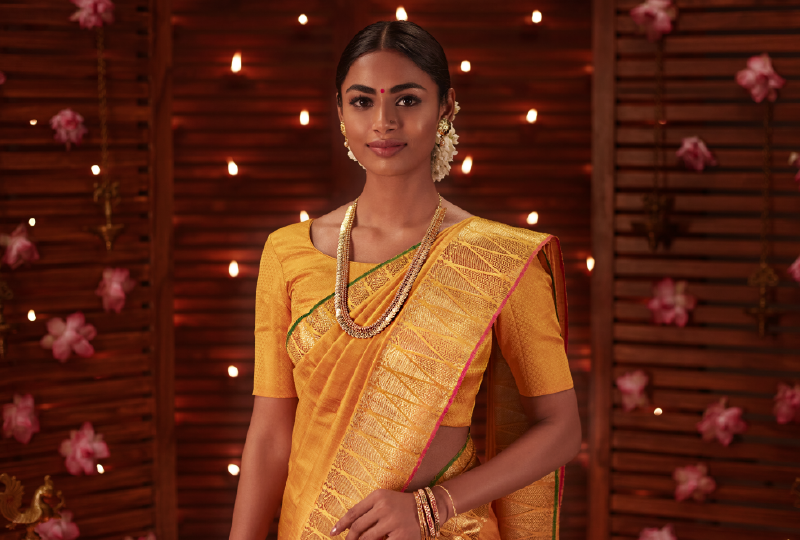Trending Products
CART
Cart is Empty!


Saree Styling Guide for the Wedding Guest
Wedding is a joyous celebration that encompasses a multitude of rituals, each with its unique significance and ambiance. As the couple embark on a beautiful journey together, a string of celebrations unfold for the wedding guests to cherish forever. In this blog, we delve into the art of styling sarees for the complete wedding rituals - from the vibrant Haldi and Sangeet to the elegant Reception and auspicious Muhurtham. Discover how to exude elegance and grace in every saree choice, creating a captivating presence throughout the wedding festivities.
Vibrant Charm of Haldi
The Haldi ceremony calls for vibrant energy and an effervescent charm. Opt for a saree in cheerful colours such as yellow, orange, or pastel shades. Choose light fabrics like cotton or soft silk blends that allow for easy movement and comfort. Embrace the occasion's jovial spirit by opting for sarees adorned with floral prints or delicate motifs, exuding a lively and refreshing vibe.

Effortless Elegance on Sangeet
The Sangeet ceremony is a celebration of music, dance, and joy. Embrace effortless elegance with a saree that allows you to move gracefully on the dance floor. Choose lightweight fabrics like chiffon or georgette, draping them in a style that complements your comfort and enhances your dance moves. Experiment with bold, glamorous colours and different draping styles like the pant/dhoti style drape.

Timeless Glamour and Sophistication for the Reception
The Reception is an occasion to opt for rich and luxurious fabrics that drape elegantly. Choose a saree in a sophisticated colour palette. Look for intricate embroidery, delicate sequin work, or shimmering zari accents that add a touch of opulence to your ensemble. Complete the look with statement jewellery and a stunning hairstyle to exude a captivating presence.

Auspicious Simplicity for Muhurtham
The Muhurtham, the most sacred of wedding rituals, calls for an attire that reflects the sanctity and tradition of the occasion. Choose a saree in classic hues like red, maroon, or shades of white and off-white, symbolising purity and auspiciousness. Opt for traditional fabrics like Banarasi silk, Kanchipuram silk, or delicate handloom weaves. Adorn the saree with intricate zari borders, traditional motifs, or timeless brocade work, paying homage to the rich cultural heritage of India.

Styling a saree is like an art. Each occasion at a wedding leaves a wide room open for creativity to curate an ensemble that expresses our style and exudes the confidence that builds within. By choosing the right fabrics, colours, embellishments, and traditional elements, you can create a presence that reflects your personal style while honouring the spirit and traditions of the wedding. Embrace the elegance of sarees and explore a wide variety of crafts, weaves and fabrics for your wardrobe.




Wedding is a joyous celebration that encompasses a multitude of rituals, each with its unique significance and ambiance. As the couple embark on a beautiful journey together, a string of celebrations unfold for the wedding guests to cherish forever. In this blog, we delve into the art of styling sarees for the complete wedding rituals - from the vibrant Haldi and Sangeet to the elegant Reception and auspicious Muhurtham. Discover how to exude elegance and grace in every saree choice, creating a captivating presence throughout the wedding festivities.
Vibrant Charm of Haldi
The Haldi ceremony calls for vibrant energy and an effervescent charm. Opt for a saree in cheerful colours such as yellow, orange, or pastel shades. Choose light fabrics like cotton or soft silk blends that allow for easy movement and comfort. Embrace the occasion's jovial spirit by opting for sarees adorned with floral prints or delicate motifs, exuding a lively and refreshing vibe.

Effortless Elegance on Sangeet
The Sangeet ceremony is a celebration of music, dance, and joy. Embrace effortless elegance with a saree that allows you to move gracefully on the dance floor. Choose lightweight fabrics like chiffon or georgette, draping them in a style that complements your comfort and enhances your dance moves. Experiment with bold, glamorous colours and different draping styles like the pant/dhoti style drape.

Timeless Glamour and Sophistication for the Reception
The Reception is an occasion to opt for rich and luxurious fabrics that drape elegantly. Choose a saree in a sophisticated colour palette. Look for intricate embroidery, delicate sequin work, or shimmering zari accents that add a touch of opulence to your ensemble. Complete the look with statement jewellery and a stunning hairstyle to exude a captivating presence.

Auspicious Simplicity for Muhurtham
The Muhurtham, the most sacred of wedding rituals, calls for an attire that reflects the sanctity and tradition of the occasion. Choose a saree in classic hues like red, maroon, or shades of white and off-white, symbolising purity and auspiciousness. Opt for traditional fabrics like Banarasi silk, Kanchipuram silk, or delicate handloom weaves. Adorn the saree with intricate zari borders, traditional motifs, or timeless brocade work, paying homage to the rich cultural heritage of India.

Styling a saree is like an art. Each occasion at a wedding leaves a wide room open for creativity to curate an ensemble that expresses our style and exudes the confidence that builds within. By choosing the right fabrics, colours, embellishments, and traditional elements, you can create a presence that reflects your personal style while honouring the spirit and traditions of the wedding. Embrace the elegance of sarees and explore a wide variety of crafts, weaves and fabrics for your wardrobe.
Our Famous Articles

Our Famous Articles
Your Ultimate Summer Wardrobe Destination
At Sundari Silks, we believe that the essence of summer...
Threads of Love: A Collection for Her & Him
What is the Meaning of Love? Love is found in...
The Story Behind the Pongal Attire
The Story Behind the Pongal Attire The Tamil New Year...


GET ON THE LIST
Perks include 5% off your first online order at Sundari Silks. Be the first to know about new collections, store launches, sales and much more!

















































































